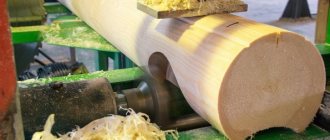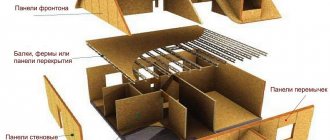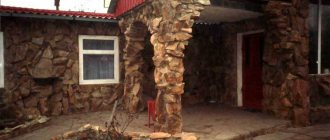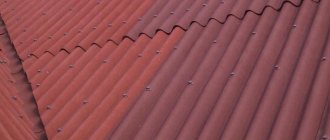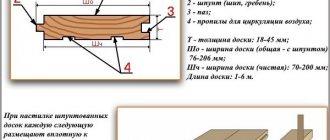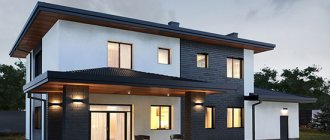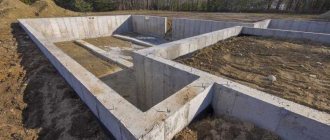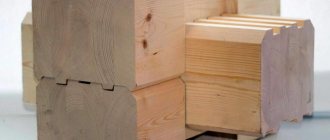6513
From this article you will learn:
- What are the characteristics of rounded logs
- How to choose a good rounded log
- What are the pros and cons of a house made of rounded logs
- What myths are circulating about houses made of rounded logs?
Rounded logs are very common in Russian housing construction as the main element for the construction of a classic wooden log house. In our country, chopped logs have been used in house construction for centuries, which explains their popularity. Today, this time-tested construction method is being updated with the latest technology, making the process of building a home easier and faster. The pros and cons of a house made of rounded logs will be discussed in this article.
“Disadvantage” No. 1: Sapwood is a protective layer of wood
Adherents of hand-cutting say that the shortcomings and disadvantages of rounded logs are already visible in production, during which the sapwood, the most important protective layer, is removed.
In fact, sapwood is the younger layers of the tree; bast and bark are adjacent to them. Let's figure out what this “strongest and most important layer” is. According to Wikipedia, the resource that is the most important primary source of knowledge of our time, it is lighter than the inner part of the log and is characterized by less mechanical strength. It contains more water, since water is transported to the crown through it, and is less resistant to attacks by fungi and insects.
#BXSTYLE_0#
The authors of the Great Soviet Encyclopedia share the same opinion, which also states that sapwood is less dense due to its role as a transport hub for water to the crown. In construction, it is believed that this part will deteriorate and wear out faster due to fungal rot or mechanical stress. In summer, pine sapwood becomes blue-black or green, and the same color penetrates to the beginning of the core. This phenomenon occurs due to the influence of staining fungi. These fungi do not spoil absolutely anything in the tree except its appearance, and they feed on substances that are present in the sapwood
How then is it possible for a less stable layer of wood to protect a more durable one?
Now let's go backwards. The most interesting thing is that adherents of this myth of deficiency say that this is precisely the most durable layer. Then timber (profiled and glued), as well as a number of other building materials, are no good at all. In this case, it turns out that all the coverings must be made of logs: frames for doors and windows, sheathing and rafters, and most importantly, work with an ax.
By logical argument, we can say that for rounded logs, the removal of sapwood is not a disadvantage. On the contrary, removing young layers reduces the risk of rotting.
And to finally refute the disadvantages of rounded logs regarding production, imagine that you are the owner of such a production. You have purchased raw materials with a diameter from 220 to 330 mm, about 2500 cubic meters. Fans of hand-cutting say that when removing sapwood, 30 or even 40% of the diameter of the log is removed. Then it turns out that at the output we get OCB with a diameter of 200 - 240 mm, and in cubic capacity we get 1500 cubic meters. The cost of such production of one cubic meter will be 10,000 rubles. As a result, it turns out that production is unprofitable, because the average selling price of rounded logs per cubic meter is 7000-7500 rubles and no one will work at a loss, this is obvious. Traditional processing from 2500 cubic meters. produces 2300 cubic meters. processed material. Due to the fact that the wood is sorted by diameter, only 1-3 cm is removed.
Advantages: Ideal surface for stable construction
The picture shows that the log has an ideal surface...
- Wood processed in a special way has not only the correct dimensions, but also an ideal surface. The material enters trade completely smooth and without any flaws. Thanks to rounding, the logs acquire a pronounced natural texture and color. Therefore, they are also successfully used as a finishing material;
- Ideal beams easily create a strong and stable structure. The completely smooth surfaces of the logs are very tightly connected to each other using grooves, locks and other additional parts, which are manufactured with high precision using a laser. At the same time, I would like to note that the Finnish groove has some advantages over the lunar groove, since it holds the wall more reliably;
- Due to the density of the rounded logs, there are practically no gaps between the crowns. As a result, this building material retains heat perfectly using standard insulation, and therefore does not require additional insulation;
- The high quality of the material guarantees that the logs will not be subject to deformation for many years. Also, due to the same diameter of the frame, there is no need to alternate laying the butt and top parts. In this case, the assembly of the object is significantly accelerated;
- It is also worth considering that beautiful rounded beams do not require any finishing, and this has a positive effect on the family budget.
Despite numerous advantages, rounded logs, just like any material, have some disadvantages. There are much fewer of them, and most of them are relative. I advise you not to be afraid of this beautiful building material. Just during the operation of the house, you need to take care of it.
“Disadvantage” No. 2: It’s cold in OCB houses!
This option is possible if you used an OCB with a diameter of 180 mm, the area of the house is 250 m2, and the house itself is heated by one oil heater.
When designing a house for all-season use, you need to consider some parameters:
- The diameter of logs for residential buildings should be from 240 to 320 mm; there is simply no point in taking more.
- The cubic capacity of the house must be taken into account: the more air there is, the more difficult it is to retain heat.
- The floors of the first floor and the roof must be insulated; they account for 17 to 23% of the heat loss of the house.
Wall material such as rounded logs have quite positive reviews. This building material is characterized by good thermal insulation and attractive appearance.
The quality of the material depends on the equipment where it was processed, on the place of growth (for OCB, the further north, the better), and also everything depends on the specialists who participate in the production.
A very important point is the correct installation of the wall kit; you need to correctly install the dowels, lay the inter-crown seal or insulation. All work must be carried out by qualified specialists: from installing a roofing pie to calculating shrinkage and caulking walls. It is also important to use only high-quality materials and appropriate tools in the construction of log houses.
Advantages of log houses
A log house has many advantages. Scientists have proven that life expectancy in a wooden house increases by several years . The tree strengthens the nervous, cardiovascular and respiratory systems. Wooden houses are also an ideal solution for people who suffer from asthma. Such houses have optimal microclimate and humidity.
From an economic point of view, wooden log houses are quite profitable. Wood, as a building material, has the ability to absorb heat from the environment and, as needed, gradually warm up the air in the room. This allows you to save on heating your home.
Not the last argument in favor of building wooden houses is their environmental friendliness . The world community has come to the idea of caring for nature and preserving its resources. Adhering to this worldview, building a house from a log frame will be a good example of a responsible attitude towards the environment. Wood, a natural material, recycling, which, after use, will not be difficult. And the comfort created with the help of this building material is difficult to overestimate.
“Disadvantage” No. 3: Rounded logs crack and burst
Naturally, any natural material with natural moisture is indeed subject to shrinkage and drying out. And that's okay - it's not plastic. But as the owners of houses made of rounded logs say, reviews and complaints that excessive cracks appear without human intervention are fictitious. Fortunately, there are sealants for sealing cracks in wooden walls; by the way, they were invented even earlier than rounded logs. To avoid the appearance of unnecessary cracks you need to:
- after the log house, treat the ends with PVA glue or lime, this promotes uniform release of moisture from the material, which means that the internal stress in the log will be significantly reduced;
- You should not cover a log with high humidity with paints and varnish, which forms a film on the surface of the material;
- Incorrectly turned on heating is the main reason for significant cracking of the log and the formation of negative reviews. After completion of construction, you must receive detailed instructions on how to properly put the house into operation and follow it.
Features of construction from rounded logs
During machining, a thick layer of wood is removed. For work, workpieces with a standard taper of 10 mm per 1 running meter are taken. The cutter removes excess layers and the result is a perfectly smooth rounded log with a uniform diameter throughout. So, for example, a workpiece with a diameter of 260 at the top and 320 mm at the butt after processing will be a rounded log with a diameter of 240 mm.
Advantages of rounded logs
- Lower cost of manufacturing a house kit.
The price for a cube of rounded Kirov pine logs of natural humidity with a diameter of 240 mm is 9,500 rubles/m3. - Neat walls and equal (before shrinkage) gaps in grooves and bowls.
After shrinkage, a “Warm Seam” is made, thanks to which all gaps and cracks are completely removed. You can choose a sealant of any color, and painting the seams is also acceptable. - Assembly is faster.
It takes 1-2 weeks to build a cottage made of rounded logs, depending on the cubic capacity. With the help of a crane you can collect 15 m3 per day. Houses are assembled by hand from rounded logs with a diameter of up to 260 mm. In a day in this mode you can build 5 m3.
Disadvantages of rounded logs and solutions
- Weakening of the natural strength of the tree due to the lack of a strong sapwood layer.
The removal percentage increases as the roundwood thickens naturally. Therefore, for houses made of rounded logs, high-quality protective compounds and their correct application are required. One of the recommended antiseptics is Lignofix, which is applied during the assembly of the house to all surfaces of bowls and grooves that are subsequently hidden. The service life of the antiseptic is 10 years in exteriors, unlimited in interiors and hidden places. Scope of action: almost all biological “enemies” of wood. - Untreated logs turn blue (pine) and darken (cedar) when exposed to fresh air.
Therefore, at the initial stage of finishing work, double sanding is needed; in some cases, the logs are bleached using special compounds. For example, Neomid 500 copes well with wood-staining fungus, which causes blue discoloration of pine. The presence of blue stains does not affect the characteristics of the wood and does not reduce the service life of chopped or rounded logs. This is only a cosmetic defect. - The logs in the assembled house sometimes twist slightly.
This occurs due to the primary curvature of the workpiece, which, during turning, leads to a displacement of the center of the log towards the edge. The problem is solved with the help of proper gelling of the log house. They use dowels made of dry birch; during installation, a distance of 1.5 meters is maintained. In one rounded log there are two dowels, staggered arrangement. - OCB cracks more severely, even despite the compensation cut.
Acrylic sealants, which are plastic, help solve the problem and can be used in interiors and exteriors. Acrylic sealants such as (Germany), “PERMA-CHINK” (USA), “ADLER RAMSAUER 160 ACRYL” (Austria) and “WOODEN WOOD” (Slovenia) deserve attention.
- A rounded log absorbs moisture more strongly.
The cutter, unlike manual processing, removes layers across the fibers, opening the capillaries. The problem is solved by using hydrophobic compounds and finishing coatings based on oil and wax. - It is impossible to make a self-jamming bowl, as in the Canadian wheelhouse.
But if you choose a Finnish profile, you can ensure a good level of fixation. The price for a rounded log with a Finnish profile is higher than for a lunar profile of the same diameter, only 300-500 rubles. for 1 cubic
On the outlets for balconies, terraces, consoles, ridges and ledges, when viewed from below, open mounting grooves are visible, which are made for the entire batch of logs. This aesthetic defect is hidden with the help of sealant and subsequent painting. The exterior of a house made from rounded logs is improved by pillars and hand-cut trusses, which can be used to decorate the entrance area.
“Disadvantage” No. 4: The cost of a house from the Central Bank is higher than the cost of a log house
A log house is good; the appearance can be as beautiful as a house made of rounded logs.
At the same time, the cost of a log house is 25% more expensive than the cost of the same house from the Central Bank.
If the cost is the same, then perhaps you are lucky, but if it is lower, then you risk getting a house in which it will be a shame to receive guests, and you will feel uncomfortable and cold there.
If you don’t believe the words, then you can’t go against the numbers:
- When producing OCB, cutting cups at the factory is free, in any case, any self-respecting factory will not indicate this as a separate item in the price list. So, for cutting one bowl by hand, you will need to pay from 200 to 500 rubles, and a “Canadian” one will cost up to 1,750 rubles for 1 piece. There are approximately 700 to 3000 of them in the house, it all depends on the number of cuts and the height of the house. It turns out that the bowls will cost from 150 thousand to a million rubles, if not more. It takes up to half an hour to make one bowl: the machine cuts one bowl in 10 seconds, but it is impossible to cut out one high-quality one in less than 20 minutes, and this is a big minus in terms of assembly time.
- Cutting a groove takes even more time, and even masters can make mistakes. Only you are not destined to find out about this, the groove is inside. There is less chance that the machine will make a mistake, and you can check the grooves during unloading. In production, running a log into a groove takes 2 minutes, and cutting a groove takes about 30 minutes, this without any additional measurements and fittings, which are impossible to do without.
- A log house needs more serious caulking than a house made from OCB. The average price of caulking on both sides is plus or minus 100 rubles per linear meter. (50-60 rubles per linear meter / 1 side) In an 8x8 house there are approximately 1000 meters of groove, you will have to pay 100,000 rubles only for caulking, which will need to be produced 2 times.
We come to the conclusion that a house from OCB can be cut on a machine in 2-3 days, and the team will do the same work for several months.
The cost of a house made from OCB in comparison with the cost of hand-cutting:
Manual cutting costs about 9,500 rubles per cubic meter with a diameter of 240-280 mm. For an 8x8 house you will need 75 cubic meters of raw materials, in total you will spend 712,500 rubles, plus lumber costs approximately 85,000, delivery and assembly for roofing felt will cost 420,000, other materials for assembly cost a total of 50,000. In general, a good-quality house without jambs will cost a minus RUR 1,250,000, without foundation, but with delivery, accommodation for craftsmen and other related expenses.
The same house, but from OCB, with perfect cups and grooves, will cost about 950,000 rubles.
Calculate the cost of the house by phone: +7, order a call back or submit an application on the website.
Price
Undoubted advantages
The main advantages of houses made from rounded logs are related to the technology of its production: it is a processed tree trunk from which the bark and upper loose layers have been removed. As a result, the house is assembled from the strongest and densest wood, which allows us to talk about its durability. Modern equipment is used in production, and all locking elements are cut with mathematical precision.
The main advantages of a house made of rounded logs:
- Easy to assemble and high speed of construction. An ordinary log has to be modified for a long time at the construction site: bowls are cut out with special tools to connect them and then adjusted for a long time. It can take several hours to lay each crown because it is extremely difficult to achieve a tight fit. The house is assembled from rounds like a construction set: all its parts are completely ready.
- Low cost. A house made of OCB is cheaper than a brick or concrete structure, and there is no need to spend money on full finishing. It is enough to caulk and paint the log house so that it is warm and beautiful.
- Maximum environmental friendliness. Wood is a natural material, and living in such a house is very comfortable. It always has a light, pleasant atmosphere with a special smell that residents of dusty concrete high-rise buildings will appreciate. It is no coincidence that wooden construction has become especially widespread in the dacha sector: it is outside the city that most city dwellers spend the summer enjoying communion with nature.
- Energy efficiency. Since the crowns fit each other very tightly, there will be no air blowing through the corners and walls. Wood itself holds heat well, and for additional protection from drafts you can use inter-crown insulation.
Weakness
When analyzing the pros and cons of a house made of rounded logs, pay attention to a number of disadvantages inherent in almost all building materials of wood origin. The rounding is exposed to various threats, and it must be constantly protected from premature destruction. Let's look at the most serious disadvantages of a house made of cylinders:
- The first disadvantages will become noticeable during the construction stage. It cannot be completed immediately after the construction of the walls; wait at least six months, or even better, a year. During this time, the main shrinkage processes will be completed. If you do not wait until the end of this period, various deformations of the finishing and roof are possible.
- But the shrinkage processes do not stop; they continue for many years. Because of this, window and door blocks are installed in casings, otherwise they will be damaged by the walls that fall every year.
- Another drawback is the need for mandatory antiseptic treatment. Wood is threatened by various biological factors: fungus, rot, mold, insects, rodents, etc. If you do not take care of impregnation with special compounds, the wood can turn into dust in just a year, and the house will be uninhabitable. The processing will have to be carried out more than once, which means additional hassle and significant costs.
Many of the disadvantages of houses made of rounded logs are associated with low-quality building materials, which, unfortunately, are not uncommon. Choose manufacturers carefully: it is best to consider offers from large companies that can provide the proper quality of wood processing through the use of high-tech equipment.

